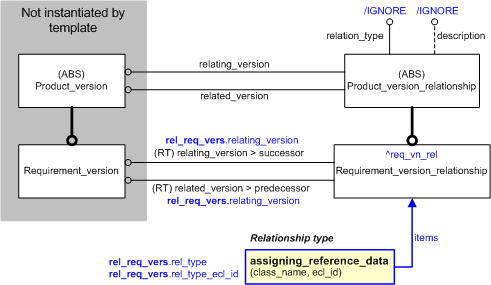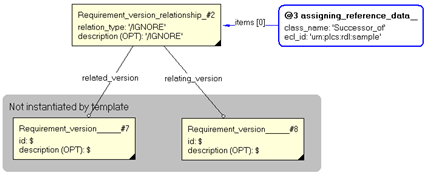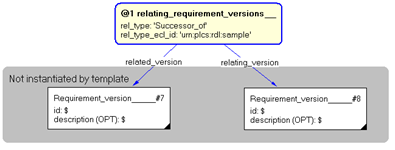Template:— relating_requirement_versions (req_ver_rel)
Capability:representing_requirements |
Date: 2009/03/16 15:14:21
Revision: 1.10
|
This section specifies the template relating_requirement_versions.
NOTE
The template has been defined in the context of the capability
representing_requirements
which provides an overall description of the
relevant parts of the ISO 10303-239 information model and a description
of related templates.
NOTE
An explanation of a template and the associated instantiation path is
provided in the
Template overview
section.
This template describes the creation of relationships between different versions of requirements.
The EXPRESS-G diagram in
Figure
1
shows the templates and EXPRESS entities that are required
to represent the template
"relating_requirement_versions".
The text highlighted in blue shows the template parameters.
Figure 1 — Relating requirement versions (EXPRESS-G diagram)
The graphic for the template to be used in other EXPRESS-G diagrams
is shown in Figure
2
below.
Figure 2 — Relating requirement versions (condensed EXPRESS-G diagram)
The following input parameters are defined for this template:
The preceding version of the requirement.
The succeding version of the requirement.
rel_type (Default=Successor_of,Type='CLASS')
The type of relationship between the versions.
The following classes and their sub-classes can be used:
The following reference parameters are defined for this template:
%^target = $relating_requirement_versions.req_ver_rel%
The instantiation path shown below specifies the entities that are to be
instantiated by the template.
A description of templates and the syntax for the instantiation path is
provided in the
Templates Help/Information section.
The following entities are instantiated with attributes as specified:
The instance diagram in Figure
3
shows an example of the EXPRESS entities and templates that are instantiated by the template:
/relating_requirement_versions(related_version='#7', relating_version='#8', rel_type='Successor_of', rel_type_ecl_id='urn:plcs:rdl:sample')/
(an illustration of the consolidated relating_requirement_versions template is shown in
Figure
4 below.)
Figure 3 — Entities instantiated by template relating_requirement_versions (EXPRESS-I diagram)
The instance diagram in
Figure
4
shows the graphic symbol for the template that is to be
used in other instance diagrams. The example template is:
/relating_requirement_versions(related_version='#7', relating_version='#8', rel_type='Successor_of', rel_type_ecl_id='urn:plcs:rdl:sample')/
Figure 4 — Instantiation of template relating_requirement_versions
Characterizations
No common characterizations of the template
relating_requirement_versions
have been identified. However, the ISO 10303-239 EXPRESS model
may enable other assignments to the entities instantiated by the template.




